Tiliqua rugosa is a unique species of skink with many common names. Bobtails, shinglebacks, sleepy lizards, and pinecone skinks are just some of the very appropriate names used to describe this robust, slow-moving reptile. Being a Tiliqua species, they share many traits with their bluetongue cousins, not least their defensive posture and iconic tongue. However, shinglebacks also display complex courtship routines, with one subspecies Tiliqua rugosa asper (the Eastern bobtail) sometimes returning to the same partner each year for 20+ years – making it one of the only truly monogamous reptiles on the planet.
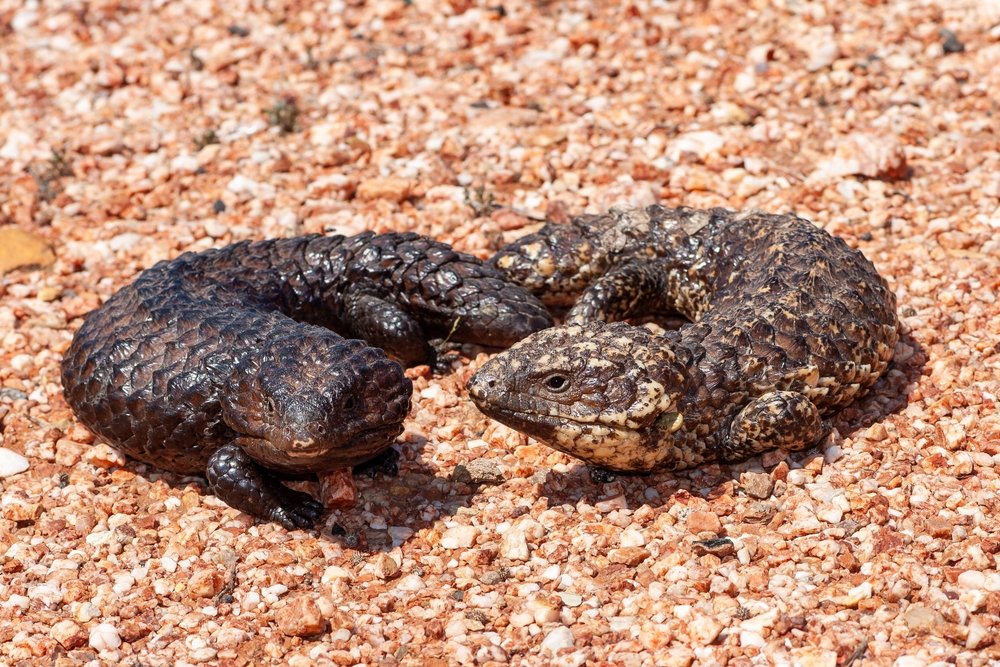
With a range that stretches across most of the southern half of Australia, there are currently four recognised subspecies of T. rugosa, the Eastern (T. r. aspera), Western (T. r. rugosa), Sharkbay (T. r. palarra) and Rottnest Island (T. r. konowi) shinglebacks.. They are widely adapted to inhabit a range of environments including semi-arid shrublands, eucalypt forests, desert grasslands and even sandy dunes. Being slow-moving, and inhabiting some of the cooler regions of Australia, they are often seen crossing and basking on warm roads in the mornings and evenings. Adapted for defence, rather than evasion, these armoured lizards can stroll up to 500 meters a day, eating almost anything that crosses their path. An omnivorous diet comprised mostly of vegetation with some molluscs, insects and carrion keep these large lizards moving. They typically eat more vegetation than other blue-tongue lizard species.
Each year in early spring (September/October) these lizards are most active. The warmer weather prompts the shingleback to begin searching for a mate and in the case of the Eastern shingleback (Tiliqua rugosa asper) their long-term partner…
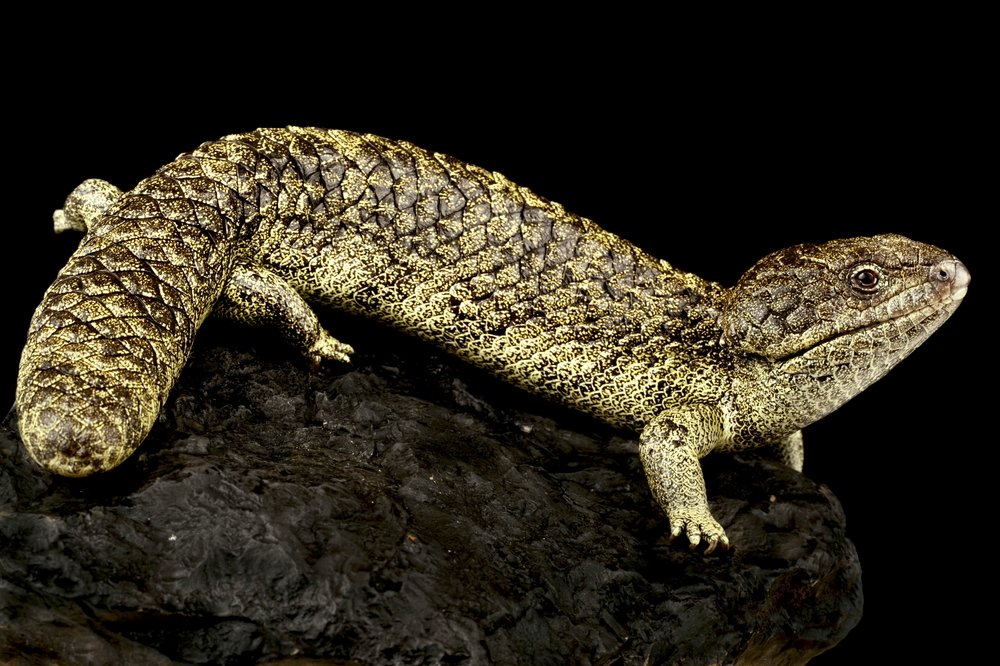

Finding the One
In the world of zoology, there are several facets to the concept of ‘monogamy’. While society tells us monogamy is having a single partner that we remain faithful to, it is slightly different for animals. Social monogamy assumes a close association of a pair of animals that involves cooperation in breeding activities. It does not imply sexual monogamy, as many species of birds will mate with several partners despite raising a chick in one ‘monogamous’ relationship. Most seemingly monogamous relationships in lizards are the result of the male ‘defending’ his chosen female or females and is thus not strictly ‘social monogamy’.
C. Michael Bull writes: “Territorial behaviour in lizards can sometimes lead to monogamy. In some lizard species, some males defend an area occupied by a single female. This may be because one female home range is as large an area as the male can defend. Stamps (1983) suggested monogamy was more common in large than in small lizards. Males can defend the relatively small area occupied by several females in a small species, but not the larger areas occupied by several females of larger species. Alternatively, in lizard populations where there are polygynous males with high quality territories, some other males may become monogamous if their poorer territories attract fewer females. In two species of Agamid lizards of the genus Stellio, some single males defend up to four females while others defend just one.”
Although lizard monogamy is extremely rare, researchers have good reason to believe there is still a lot left to learn. Anecdotal studies of High-casqued chameleons (Trioceros hoehnelii) suggests that partners will return to one another in successive years, Anolis spp. present extremely complex social relations we’re yet to fully understand and Southern snow skinks (Niveoscincus microlepidotus) will form pairs for up to a month before breeding. Figuring out animal behaviours, particularly in species that are not readily bred in captivity can prove to be extremely challenging. However, researchers in Australia have managed to work extensively with the ‘sleepy’ lizard, tracking these slow-moving and large lizards with relative ease to paint the first full picture of a monogamous lizard.

Cursed by Monogamy?
Although we know that male shingleback lizards will pursue a female for the entire breeding season and, in the case of the Eastern shingleback, will usually return to a single individual for many consecutive years, scientists are still not sure why they are monogamous. In fact, researchers believe that this relationship could have both positive and negative impacts on the survival of the species. Bull writes “we can speculate that there would be relatively low cost in locating and pairing with a new partner each year, because all lizards are effectively unpaired at the beginning of the season. Indeed, there may be real reproductive benefits in swapping partners because not all females reproduce every year.” This is puzzling, as Eastern shingleback males will still follow their partner female, each year, whether she does or does not reproduce. Whilst this may sound romantic, it is difficult to make sense of.
Another romantic theory is the selection of a “reliable” partner. Knowing that a partner will generally reproduce strong offspring or possess traits that may be passed onto the young will offset the years that the partner does not reproduce at all.
Bull added: “Familiarity with a partner may be an advantage of long-term pair fidelity. Familiar partners may be more efficient at feeding, or at detecting predators. They also may be reproductively more efficient. Young are born in autumn and have little time to forage for their own food before the winter, when they must rely on stored energy reserves. Early next spring, six-month-old young weigh little more than at birth. Mortality of juveniles in their first winter is very high. If females could mate earlier, young could be born earlier, or larger, giving them a greater opportunity to survive the winter.”
The shingleback’s unique protective scales, whilst visually stunning, also manage to harbour ticks and parasites quite easily. Ectoparasitic ticks are vectors of the blood parasite Hemolivia mariae. Bull continues: “Another possible function of long-term monogamy could be to prevent the spread of parasites and diseases. It may be advantageous for an individual lizard to remain with the same partner if it did not get infected in the previous year, and if other potential partners may be more infectious.” Whilst studies into the courtship rituals of the Eastern shingleback are widely documented but still inconclusive, observations of other shingleback species are fuelling yet more confusion.
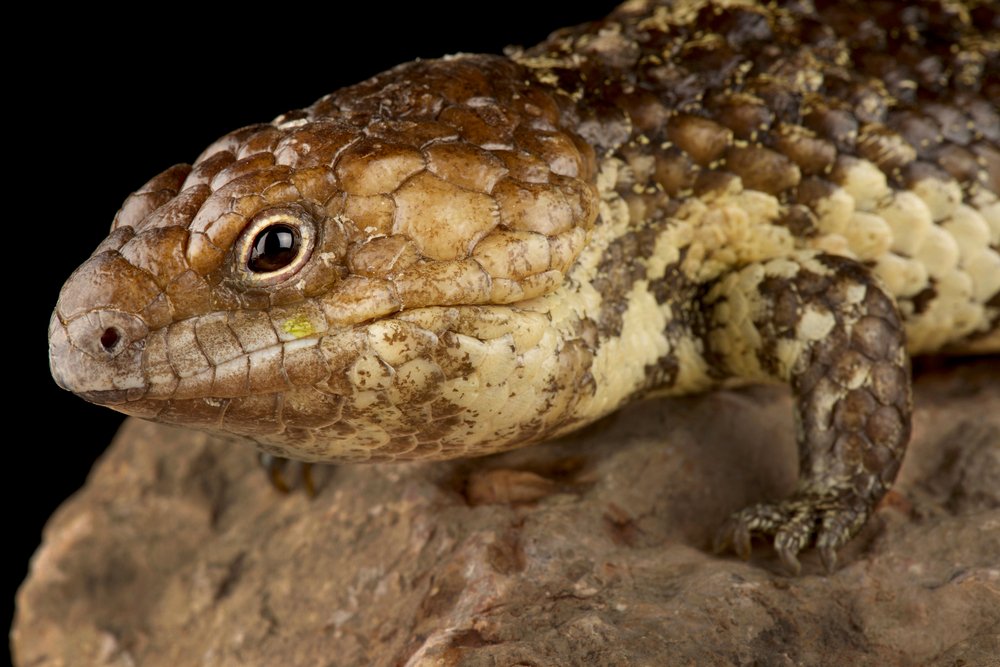

Captive Breeding
Tristen Pace is an experienced breeder of T. rugosa rugosa, the Western shingleback. He told Exotics Keeper Magazine: “Whilst monogamy has been shown in some excellent and truly amazing studies performed on wild populations of Tiliqua rugosa aspera, and while it likely does occur, to my knowledge this behaviour has not yet been proven in other subspecies.”
“It is certainly not the norm in captive breeding, where one male can cover several females in a single season. I can only assume that the bonding process that occurs over several weeks both in the wild and in captivity, helps to prove that a male partner is a worthy mate. Given the substantial investment the female puts into producing such massive babies, it would make sense that they put as much effort as possible in selecting a healthy and genetically superior mate.”
Tristen started breeding shingleback skinks in captivity over 20 years ago. Living in Western Australia, he has a unique opportunity to breed these lizards outdoors, giving us a rare glimpse at how they can be bred successfully. Tristen continued: “In the wild here in WA, you start to see pairing behaviour from around early September, and this continues to early November. Some population densities are extremely high, and it is not unusual to see several males following a single female. This is usually a very ordered and polite process with the female at the front then several males following in single file as she goes about her daily business. Males seem to be attracted to movement and I have not seen any males continue to stay next to the body of his mate after she is deceased, as reported in aspera (Eastern shingleback).”
Tristen set up his breeding project Goldfields Rugosa 14 years ago with a desire to line-breed visually stunning skinks from the goldfield region of Western Australia. Tristen continued: “I had been living in Perth for a few years by that stage and whilst I loved seeing and photographing our local shinglebacks, it was only after seeing photos of animals from the goldfields region of Western Australia, that I gave consideration to keeping them.”
“Shinglebacks are maybe not the best choice for line breeding at first glance, by virtue of being more challenging than most reptiles to breed, being slow to reach maturity and having frustratingly small litter sizes. However, the extreme natural variation of colours did provide some important advantages. Whilst most shinglebacks from the goldfields are mainly black, with varying amounts of orange/red and white markings, there are animals that are a more extreme orange in colour that make up maybe 1% of the wild population. It is these animals that formed the focus of my breeding project.”
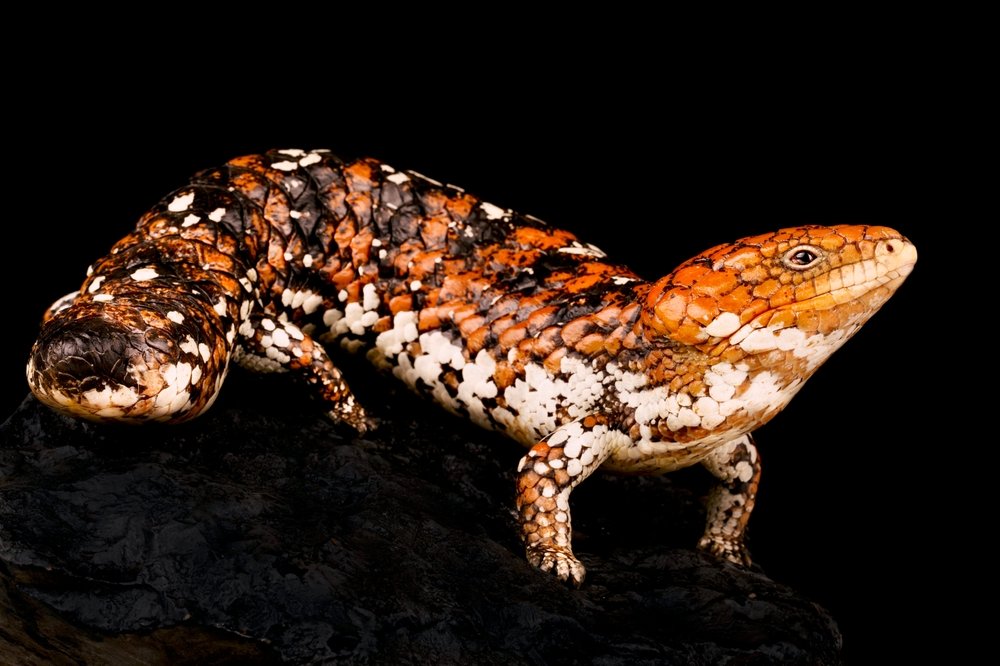
Acting Cupid
Despite not being strictly monogamous like their Eastern cousins, pairing Western shinglebacks together for a successful breeding season demands some care and attention. As a notoriously picky species, Tristen is required to search for clues for a compatible match. “The choice between them comes down, in part, to the individual personalities and characteristics of the animals being bred” explained Tristen. “I find both male and female shinglebacks to have a wide range of personalities when it comes to breeding, with some being much more aggressive and some much meeker. My best breeder males are generally the largest and most dominant without being overly aggressive. These males I will pair with up to 5 females in a group for the entire breeding season.”
“For males that are younger or a bit meeker, I generally pair them in groups of 2 males with multiple females and select females that are a bit smaller and less likely to be aggressive. I found the addition of the second male provides some competition and seems to spur on interest in breeding, however care must be taken to observe for signs of hostility as fighting can lead to serious injuries.”
“The males will follow the females for about 7-8 weeks from the start of September, however actual mating does not take place usually until mid-October. Mating usually takes place in the early morning and males will test bite females to see if they are receptive. The females will also give the males cues that they are ready to mate, through posture and movements.”
“Females will at times show interesting behaviours and can even act “male”, by following both other females and males, simulating mating, and showing increased aggression and even fighting with males. This tends to happen around certain times (e.g. ovulation) and is more likely with females that are unmated, or when paired with a male who is a poor breeder or less dominant. Dominant or hormonal males can also at times simulate mating with other less dominant males (although more often these attempts lead to fighting). Unfortunately, I have seen this lead to confusion in more than one keeper as why their shinglebacks will not breed over many years, despite being sure they have a pair after witnessing mating activity, only for them to turn out to in fact be 2 females.”
In Europe, providing everything required to ensure a healthy breeding pair of shinglebacks can be notoriously difficult. Furthermore, certain locales and subspecies are under increasing pressure from illegal harvesting and export. The provision of an outdoor enclosure, natural plants, lots of space and essentially perfect UVI readings means that maintaining reptiles in their native range is undeniably the most successful way of providing good husbandry and receiving good breeding success. Tristen continued: “My adults are kept outside for the majority of the year in pens that are essentially garden beds with glass fencing around them, except for around 6-8 weeks when I bring them inside for brumation in mid-winter. I find keeping outside provides more space and improves breeding success and improves colouring (the intensity of the reds in particular).”
“I raise the babies inside generally for the first year of life as this gives more consistent results. They are fed a diet that consists of about 60% fruit and vegetables, with the other 40% being a protein source such as wet dog food. I supplement the baby’s diet with calcium and vitamin D. Whilst a diet that is higher in protein can give increased growth and improved weight gain, I find it causes an increase in darker pigments and overall duller colouration. As they eat grains as part of their natural diet, I do not worry about feeding any grain-free foods.”
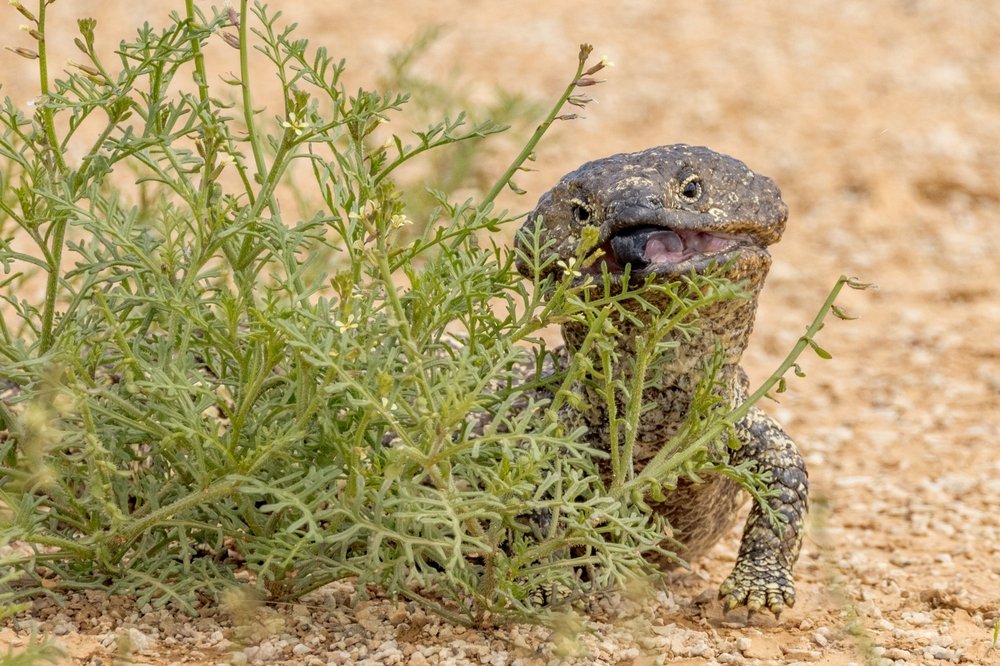

Illegal exports
More than 90% of Australia’s reptile species exist no where else on earth. Yet, between 2018 and 2019, 90% of all wild animals seized by authorities in Australia were reptiles, according to data from the Australian Department of Agriculture, Water and Environment. Unfortunately, shinglebacks fall into this category and new data published by Monitor Conservation Research Society suggests over 500 individuals were intercepted in the last decade.
The new research is aimed to impose tighter CITES regulations on otherwise common species. Because shinglebacks are easy to capture, reasonably abundant and regularly found in breeding pairs, they are the target of many poaching efforts. T. rugosa konowi on Rottnest Island is famed for its speckled appearance and smaller size and has now been officially listed as ‘threatened’. The population of T. rugosa rugosa from the Goldfields is also becoming increasingly popular amongst smugglers. This emphasises the important work that Tristen is doing to ensure a good number of captive bred animals.
Tristen explained: “Using captive bred stock is by far and away the most important single factor you can have in breeding success. This is probably even more important for those who are overseas. Shinglebacks also require plenty of space (I would suggest a minimum of 1m2 per animal) along with plenty of privacy if you want them to breed. Conditions also need to be consistent. Shinglebacks are creatures of habit. It can take several seasons for them to feel comfortable in a new environment.” All these factors mean that illegally harvested individuals will generally make terrible breeding animals. It also highlights the difficulties that anyone overseas might encounter when keeping or breeding shinglebacks, so serious consideration is needed when sourcing these lizards.
Despite the species being abundant across most its range, by giving birth to (usually) just two offspring, it amplifies the genetic and ecological importance of the individual. The study previously outlined by Bull states: “Another explanation for long-term fidelity may be that partners are more compatible to each other genetically than they are to other potential partners living nearby… Females in this sample were significantly less related to their male partners than they were to the other males that overlapped their home ranges. The monogamous pair should produce offspring that are more outbred than if the pairing had been at random. An implication is that lizards in the population can recognise and discriminate against related individuals.”
By impacting the genetic diversity of a localised population just slightly, it can have drastic effects on certain species. Furthermore, common species with high price-tags prompt poachers to harvest much rarer species to fill their illegal shipment. There are of course arguments for legalising the export of all animals to ensure correct paperwork and managed quotas are met. Australia’s generally strict policing of wildlife trade has caused a lot of illicit trade to satisfy global demands. However, some of the hobby’s most-loved species come from this nation and would have almost certainly been illegally traded at some point. It is down to the consumer to do everything in their power to ensure that a species which obviously comes from a nation in which exports are illegal, has been captive bred. Blue-tongue skinks can make wonderful pets and have been popular for decades, but only a few varieties are regularly captive bred in the UK, namely T. gigas (Indonesian blue-tongue) and T. scincoides (Common blue tongue – of which, the Northern and Indonesian varieties are most widely bred).
Tristen Pace (Goldfields Rugosa) on Shingleback Locales
Tiliqua rugosa aspera – The Eastern shingleback.
“These are in general larger and stockier than other subspecies. They have larger and more prominently keeled scales. Colours are darker, consisting of mainly black/browns, with varying amounts of white, tan or yellow patterning.”
Tiliqua rugosa rugosa – The Western shingleback.
“By far the most variable subspecies in terms of colour. Generally slimmer with longer and less bulbous scales than the eastern subspecies. Scales are smoother and often quite glossy. The heads are usually lighter and brighter, with patterns along the body that can consist of clearly defined bands, to spots and speckles. There are several recognised colour variations in the hobby, loosely based on their geographical range.”
Coastal forms – “can be found in sandy dunes and coastal heath from north of Perth, extending all the way as far as Esperance. These are generally lighter in appearance with a base colour of white or grey, with varying amounts of brown, tan, yellows and orange.”
Hills form – “Similar in appearance to some coastals, but generally deeper/richer shades of brown, tans and oranges.”
Goldfields – “Larger and stockier, with often very glossy scales. Colours consist of varying amounts of orange, red, black and white. Most wild individuals are mainly black, with orange heads and small amounts of orange spotting or stripes along the body and tail, however as mentioned above, in a small number of individuals (maybe 1% of the wild population) the orange dominates with much reduced black and white patterning.”
Wheatbelt – “Mainly dull browns with dull orange to tan heads and markings along the body.”
Northern Coastal – “Less oranges than the southern coastal forms, with a base of white/cream with varying amounts of greys and brown patterning. In some forms the base colour can take on a greenish hue, and these are often mislabelled by smugglers as the Rottnest subspecies.”
Geraldton/Murchison – “Much darker, with a base of blacks and dark brown, with smaller amounts of white/cream markings. In many overseas collections (including much of Europe) these are incorrectly labelled as T. rugosa palarra.”
Tiliqua rugosa palarra – the Shark Bay shingleback. “
Generally dark in appearance with varying amounts of white and cream patterning. Heads are often dark and similar in colour to the body. Scales are smaller. Heads are shorter with more pointed noses. Tails also shorter and more pointed.”
Tiliqua rugosa konowi – The Rottnest Island shingleback.
“By far the smallest subspecies. Base colouring greenish grey with overlying patterning of darker greys. Range restricted to Rottnest Island off Perth. Listed as vulnerable to extinction, with poaching from the wild for the pet trade being a major threat.”